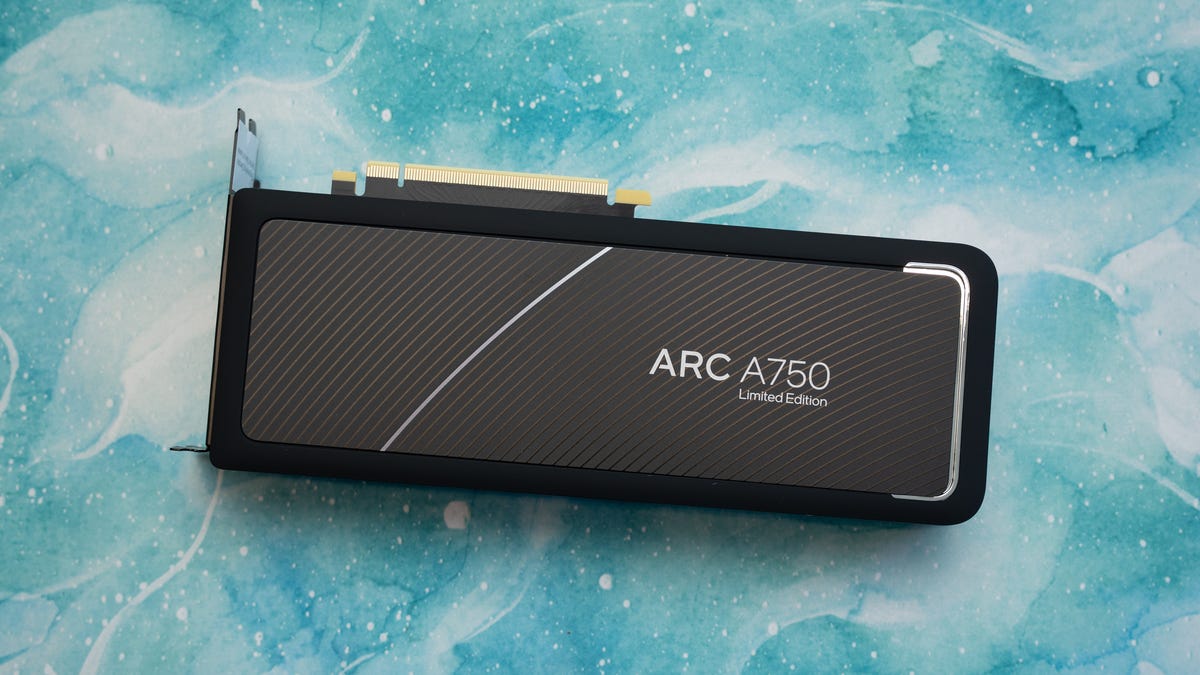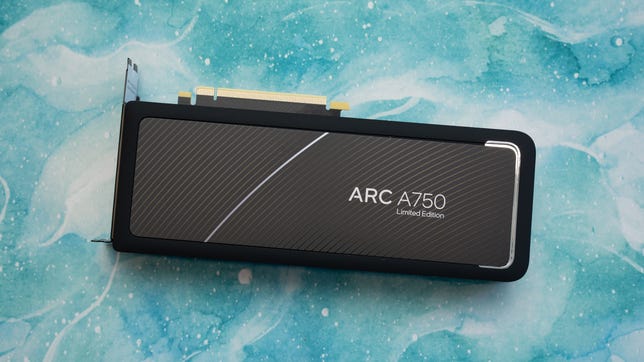 Why You Can Trust CNET
Why You Can Trust CNET Intel Arc A750 LE Graphics Card Review: A Sub-$300 Speed Champ
But it doesn't score quite as high on stability.

Intel came very (very) late to the party with its desktop graphics cards, so it's not surprising that they feel like a bit of a work in progress compared to veterans like Nvidia and AMD.
From a price and specs perspective, the A750 competes with Nvidia's budget GeForce RTX 3050, which also falls roughly into the $250 to $300 price band. Intel dropped the price from $300 to $250 in February, but the market doesn't seem to have totally caught up with that yet.
Like
- Good price for its performance
- AV1 encoding support
Don't like
- Experienced some instability
- large for its performance class
The Arc line currently includes a sub-$150 8GB entry-level Arc A380 and upmarket A770, which comes in two flavors: an Intel Limited Edition, with 16GB VRAM, and one available through board partners such as ASRock and Acer. The latter cards have bulked-up specs, notably four additional Xe graphics cores and faster clock speeds. So for less memory-demanding 1080p gaming the 8GB A770 might provide a little lift over the A750 -- but it may not be worth the extra cash, depending on what they're going for at any moment.
I'm not convinced the 16GB version makes a lot of sense. If you need that much memory, say for video editing or 1440p-plus gaming, you're going to want more powerful components.
Intel Arc A750 Limited Edition
| Intel Arc A750 Limited Edition | |
|---|---|
| Memory | 8GB GDDR6 |
| Memory bandwidth (GBps) | 512.0 |
| Memory clock (GHz) | 2.0 |
| GPU clock (GHz, base/boost) | 2.1/2.4 |
| Memory data rate/Interface | 16Gbps/256 bits |
| Render Slices/RT cores | 4/28 |
| Texture mapping units | 224 |
| Tensor Cores | 448 |
| Process | 6nm |
| TGP/min PSU | 225/600W |
| Max thermal (degrees) | 194F/90C |
| Bus | PCIe 4.0x16 |
| Size | 2 slots; 11.1 inches long (282mm) |
| Connections | 3 x DP 1.4, 1 x HDMI 2.0 |
| Current list price | $249 |
| Ship date | October, 2022 |
You can get surprisingly reasonable 1440p performance out of the A750, especially if you're aggressive with XeSS (Xe SuperSampling), the company's upscaling technology a la Nvidia's DLSS or AMD's FidelityFX Super Resolution.
Keep in mind that if you're upgrading an old system you may not get claimed (or as tested) performance. And by "old" I mean pre-2020 or earlier than Intel's 10th-gen and AMD's Zen 3 desktop CPUs. That's because best performance requires resizable BAR support, which lets the CPU store its game-related data in the GPU's VRAM rather than system RAM so the GPU doesn't have to traverse the system bus to retrieve it. But the same RBAR performance caveat applies to most recent GPUs.
The A750 LE is a full-length card.
The visible design aspects are pretty typical for a GPU: two fans on one side, vents on top and bottom and out the end. It's heavy for its class, but there's a lot of metal and thick, sturdy plastic. You can add a waterblock, though I could only find a couple compatible ones, one of which costs as much as the card. And removing the backplate can potentially get ugly, since it's glued rather than screwed on. (I didn't disassemble mine, but TechPowerUp has a nice teardown of it.)
The A750 takes up two slots.
Performance
I've compared the A750 to the RTX 3060, since the EVGA RTX 3050 I reviewed is no longer produced -- the company left the business in September 2022. The Asus Dual RTX 3060 OC is more expensive by about $100, but isn't always the faster card. And even where the A750 lags it, for 1080p gaming it doesn't do so by much. The RTX 3060's 12GB of VRAM helps when you bump up resolution or do graphics work, but the newer architecture of the A750 means it acquits itself better than the two-year-old 3060 on operations like ray tracing. And because it's not an old entry GPU, it supports AV1 encoding (for better streaming performance), while other low-end -- Nvidia and AMD's entry- and midlevel GPUs are still based on last-gen architecture.
My biggest gripe about the A750's performance, though, isn't about frame rates, it's about the driver and related software. Some conflict with my network card -- an Intel Wi-Fi 6E AX211 -- made my system report it as having failed in Event Viewer, despite all indications to the contrary. It was still operational, though. But I never would have seen those event reports had I not been trying to track down the cause of freezes/BSODs. Removing the card and uninstalling the driver restored stability. Could be correlation, not causation, but I haven't seen a BSOD in a long time.
Intel also configures its Arc Control Utility's default well below the card's stated maximum power consumption -- 190 watts vs. 228 watts -- which makes sense. For one thing, I saw only about a 4% frame-rate increase bumping it to 215 watts. But it also runs hot once you start playing with the overclocking settings, easily hitting its 90C maximum (and slightly above), and definitely hot enough to start exhibiting display glitches.
Overclocking anything runs the risk of system instability, but Arc Control doesn't make it easy (or less tedious) to iterate through the possibilities.
These kinds of issues are normal for early generations of GPU technologies, and Arc is just a baby, which makes it a hard call against veteran competitors. But if you want something fast for less than $300, the Arc A750 is an attractive proposition. Just keep in mind you may have to change some GPU diapers.
Relative performance of comparable GPUs
Shadow of the Tomb Raider gaming test (1080p)
Guardians of the Galaxy (1440p)
3DMark Time Spy
3DMark Speed Way (DX12 Ultimate)
SpecViewPerf 2020 SolidWorks (1080p)
3DMark DXR (DirectX Ray Tracing)
Test PC configuration
| Custom PC | Microsoft Windows 11 Pro (22H2); 3.2GHz Intel Core i9-12900K; 32GB DDR5-4800; 2x Corsair MP600 Pro SSD; Corsair HX1200 80 Plus Platinum PSU, MSI MPG Z690 Force Wi-Fi motherboard, Corsair 4000D Airflow midtower case |
|---|


